If you are in the healthcare sector, you know it is an industry where precision and preparedness are non-negotiable. Today, healthcare and medical organizations are under pressure not just to train, but to train smarter.
That’s where a dedicated Healthcare Learning Management System (LMS) comes into play. It works more than a digital tool-a strategic investment in people, performance, and patient outcomes.
But here’s the twist—building a healthcare LMS isn’t like developing your average corporate training portal. Healthcare has layers: regulatory standards, medical jargon, role-specific modules, continuing education credits, and often, mission-critical simulations.
So if you’re a healthcare organization or health tech firm asking, “How do we build a system that actually works for our teams on the ground?” — this guide is tailored for you.
From understanding industry-specific requirements to choosing the right tech stack and ensuring HIPAA-compliant architecture, we’ll walk you through everything you need to design a healthcare LMS that’s not just functional, but future-ready.
So, why wait then? Let’s get going
Table of Contents
What is a Healthcare Learning Management System (LMS)?
A Healthcare Learning Management System (LMS) is a specialized digital platform designed to manage and deliver training and educational content for professionals in the healthcare industry. It helps hospitals, clinics, and medical institutions train their staff more efficiently through online courses, interactive modules, certifications, and progress tracking—all in one place.
Unlike general LMS platforms, healthcare LMS systems are built with industry-specific needs in mind. They support compliance training (like HIPAA or OSHA), onboarding for new medical staff, ongoing skill development for nurses and doctors, and emergency protocol updates. The platform allows healthcare organizations to standardize training across departments and locations while tracking individual progress and ensuring everyone meets regulatory standards.
Why the Need for Healthcare Learning Management Systems Is Growing?
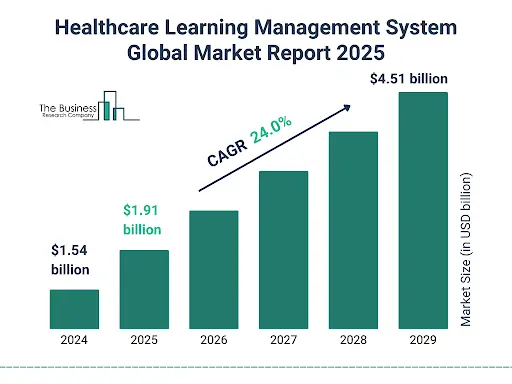
(Source: The Business Research Company)
According to the latest market report released from The Business Research Company, the healthcare learning management system market size grew from $1.54 billion in 2024, and is estimated to reach $1.9 billion in 2025 and $4.51 billion in 2029 at a CAGR of 24.3%.
This substantial growth in healthcare learning management systems is due to the increased need for cost-effectiveness in healthcare management and speed in medical training. So, what are those factors which are pushing the demand for learning management systems for healthcare? Below are mentioned.
1. High-Risk Industry, Zero Tolerance for Any Margin of Error
In the healthcare delivery system, even the smallest mistakes could escalate into great harm. Day-to-day, healthcare personnel must keep up with accepted practices, technology, and regulatory standards at all times.
Unlike most other fields, training is not an addendum in this case but a requirement. Thus, demand has risen for healthcare learning management systems, offering them narrowly focused and real-time training that is traceable to clinical and operational roles.
2. Compliance Is a Dynamic Discipline
The constant evolution of regulations in healthcare—be it HIPAA rules, JCAHO standards, OSHA rules, or region-specific regulations—has rendered conventional training meant to keep teams compliant very challenging. And that’s where healthcare LMS software comes into the picture, assisting organizations in updating compliance at the blink of an eye, allowing for tracking completion and audit-ready reports without inputting the manual method.
3. Remote Learning Is the New Normal
Hospitals and healthcare facilities, in this post-pandemic era, operate not only brick and mortar but virtually across time zones, shifts, and even continents. Whether it’s getting staff onboarded or offering refresher courses, healthcare LMS systems offer an opportunity to manage all training under one virtual roof that could be accessed anywhere, anytime.
4. Increased Pressure on Upskilling and Multidisciplinary Training
Modern healthcare teams develop an interfacing mosaic of cross-functional roles. Nurses require data handling skills, the administrative team desires to get cybersecurity on board in patient care data management, and what not. It has gone from being a value-add to a survival strategy. Every LMS system for healthcare is not just about stable content—it offers learning paths, continuous accreditations of its featured personnel as their roles evolve.
5. Mobile-First Training Is Now a Must-Have
Healthcare professionals are rarely behind desks—they’re on the move. This shift demands healthcare LMS systems that are mobile-friendly and intuitive. For instance, the involvement of a forward-thinking mobile app development company in Dubai, if you are based in this city, becomes essential here to create learning experiences that feel natural on smartphones and tablets, ensuring that learning happens seamlessly, even in 12-hour shifts
6. Hospitals Must Have More Than Just Videos and PDFs
Hospitals are no place to have people trained. They are medium-critical environments. Generic training platforms are not cutting it anymore. Organizations now want to develop LMS for hospitals that provide simulation-based modules, role-specific dashboards, peer learning features, and real-time tracking concerned with patient care. And so, this customization push is one of the key reasons why certain hospitals have chosen to invest in making more sophisticated LMS solutions suited to their sector.
Read Also : A Business Guide To Healthcare App Development
Building a Healthcare Learning Management System (LMS): Step-By-Step Guide
Now, let’s discuss the steps which are required to develop a healthcare LMS
1. Define Your Training Goals & Compliance Needs
A key part of any development requires, in the very first stages, a strong apprehend of what the overall aim and goal of this LMS is going to be. Now, is this about improving training-induced competence at onboarding ramp-up? Reducing compliance risk, preferably without any kind of mishap? Or rather, trying to increase proficiency in the clinical setting?
It is noteworthy that achieving this effective focus will provide the support on which the LMS is built. Especially in the healthcare field, where you have no flexibility to go against the compliance rules like HIPAA, OSHA, GDPR, and so on. Building a healthcare LMS that delivers value can be achieved only if the content and architectural design are directed toward operational goals from the word go.
2. List Down Must-Have Features of Your Healthcare LMS
Begin distinguishing between those LMS systems for any certificate and nurse’s aids directly regarding on-boarding and the customary advanced-ed teacher, and this requires some knowledge about learning; otherwise, not every LMS found can be enough.
The perfect LMS for healthcare is not the one with unending features, but the one that precisely attacks your training problems. Some of the critical learning management system features that you can incorporate into your platform such as:
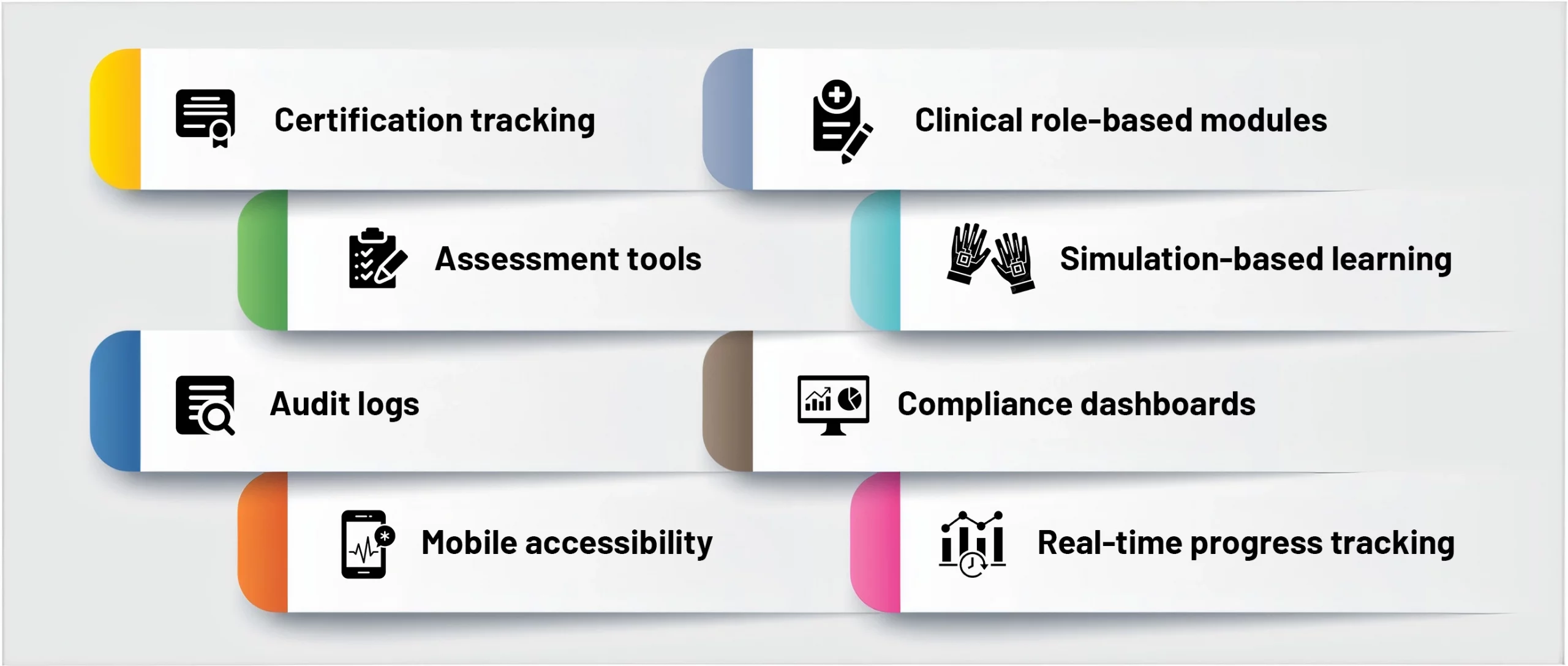
3. Going for a Development Route That’s Best for You (Custom > Generic)
Generic LMSes usually have a short lifespan in healthcare organizations. This is because hospitals and clinics have very unique requirements and, consequently, call for deep personalization: something that only customized LMS development can achieve.
That gives the stranglehold in setting the best user experience, workflows, integration with Hospital Information Systems (HIS), and scaling architecture, much tailored to your organization’s evolving training needs. Here, hiring a custom app development company for this task can help you make sure that your LMS is designed not just for aesthetics but for results-driven learning.
4. Select the Right Tech Stack (Think Future-Proof)
Choosing the right tech stack is crucial to ensure your healthcare LMS is secure, scalable, and future-ready. The current era has become much advanced from yesterday’s LMS-based concepts, accepting nothing much except video hosting and quizzes. Prioritize technologies that support HIPAA compliance, mobile accessibility, easy integrations, and fast performance.
Whether you’re building with React, Flutter, or leveraging cloud computing in healthcare like AWS or implementing AI in mobile app development, make sure your choices align with your LMS’s learning goals and user workflows. Always partner with experienced healthcare app developers who understand both the technical and regulatory demands of the healthcare industry.
5. Find a Dedicated Company for Building LMS for Healthcare
Building a healthcare LMS is not a regular tech project. It sits at the intersection of health compliance, training science, and user experience. And unless you’re working with a partner who deeply understands these nuances, you’re risking time, budget, and long-term performance.
Instead of handing over your vision to a generic vendor, look for a dedicated healthcare application development company that specilizes in building healthcare learning management systems. They’ll come equipped not just with developers, but with a product mindset—knowing how to integrate EHRs, secure sensitive data, and personalize learning experiences for different medical roles.
6. Think User-Centered Design Built for Learners
A good LMS should feel like a natural part of your team’s workflow, not another burden. From intuitive dashboards to mobile-first UI/UX design, the user experience should be effortless for both administrators and frontline healthcare workers. The best LMS for healthcare should be one that your people actually use.
7. Integrate Secure Data with Performance Tracking
Your LMS will collect massive volumes of data—completion rates, test scores, compliance records, login times, and more. Build data pipelines that not only track this activity securely but also make it actionable. It’s no longer enough to know who finished a module; what matters is how they engaged, where they dropped off, and what they need next. Therefore, data security and analytics features should be baked into the system from the start, not bolted on later.
8. Launch in Phases & Continuously Optimize
Don’t fall into the “launch it and forget it” trap. Roll out your LMS in a pilot phase, gather real user feedback from every department—nurses, doctors, compliance teams—and refine based on data. Post-launch optimization is where LMS platforms either stagnate or scale. So, you should try to plan the launch of your healthcare LMS in phase wise to timely update as per user needs.
Cost to Build a Healthcare Learning Management System (LMS)
On average, the cost to develop a healthcare learning management system can fall between $15,000-$30,000. However, unlike off-the-shelf training portals, LMS systems for healthcare demand precision. They must align with compliance, medical workflows, and tailored learning journeys for clinicians, nurses, and admin staff. So, when it comes to cost, don’t expect a flat number.
That said, here’s a practical breakdown of what you can expect:
| Development Category | Estimated Cost (USD) | Includes |
| MVP/Prototype Development | $15,000 – $30,000 | Basic modules: user management, content upload, simple reporting |
| Custom Mid-Level LMS | $35,000 – $70,000 | Role-based learning paths, compliance modules, assessments, analytics |
| Enterprise-Grade LMS | $80,000 – $150,000+ | AI features, EHR/HRMS integration, certification tracking, cross-platform UI |
| Ongoing Maintenance & Scaling | $1,500 – $5,000/month | Cloud optimization, updates, bug fixes, new feature rollouts |
To get an exact price estimation, it is advisable to consult a dedicated healthcare app development company USA if you are based in this country. However, if you’re still in the ideation stage, exploring different healthcare app ideas, an MVP version is a good place to start. It gives you a functioning core without burning capital too soon.
Best Examples of Healthcare Learning Management Systems You Can Learn From
From mandatory training to soft skills to handling patients with care, healthcare learning management platforms work quietly to empower patient outcomes. These examples demonstrate that a suitable LMS can remove friction, enhance learning retention, and bring duly certified compliance training into the realm of healthcare. Whether you are creating an LMS for health care from the ground up or looking at established vendors, knowledge of these platforms will expedite your decision-making process.
1. HealthStream
The content and delivery cow kicked off entirely by HealthStream is in the healthcare category. Their software is used in hospitals and nursing homes across the US for clinical and soft-skill training. HealthStream stands out thanks to some features like compliance tracking, credentialing, and competency-based learning, among developers who provide ready-to-use enterprise-grade learning management system features.
→ What really makes HealthStream worthy: It is made mainly on what it believes are real workflows in clinical settings, certifications, licensure tracking, and includes EMR system integration.
2. Relias Learning
Relias spends on learning that focuses on developing sets of behavioral indicators; it uses adaptive learning paths, analytics, and mobile accessibility for healthcare professionals not merely to study but to be retained and applied. There are users from long-term care facilities, rehabilitation centers, and mental health organizations.
→ What really makes Relias work: The predictive analytics and real-time performance feedback are a perfect match for fast-paced care environments.
3. TalentLMS
If not healthcare-exclusive, the platform will already come with hospital or clinic templates. This system has been adopted by smaller establishments or private practices that were looking for something that is within their budget and scales well.
→ What really makes TalentLMS click: They are as sharp as it comes, balancing the vital customizations while considering the costs when starting a healthcare LMS journey.
4. Docebo Healthcare LMS
Docebo collects automation and AI in the LMS casing. It is built for the large hospital chains and large healthcare organizations. It is known for its smart localization, various languages, and deep integration with clinical systems.
→ What really makes Docebo particularly practical: The platform can scale, which makes it easy to customize per the organization’s specific needs and falls in line with the requirements of enterprise healthcare systems.
Final Thoughts
The future of healthcare training doesn’t rest in dusty handbooks or scattered compliance files. It now lives in intelligent, scalable systems that grow with your organization. A well-designed healthcare learning management system is the backbone of safer healthcare, faster onboarding, and better clinical decision-making.
And that’s exactly where partnering with the right tech partner makes the difference between “just another system” and “a tool your team actually needs. RipenApps here stands among the leading mobile app development company USA that specializes in building industry-ready healthcare LMS for all use cases.
FAQs
1. Should I Build or Buy a Healthcare LMS?
Build if: You need custom workflows, integrations with existing hospital systems, or specific features that off-the-shelf platforms can’t offer.
Buy if: You need a quick launch, standard compliance, and general e-learning capabilities without heavy customization.
In short, build for control and scalability, buy for speed and simplicity.
2. How Much Does It Cost to Create a Healthcare LMS?
The cost varies based on features, complexity, and region of development. On average:
- Basic MVP: $25,000 – $40,000
- Mid-tier custom LMS: $50,000 – $80,000
- Enterprise-grade system: $100,000+
If you partner with a mobile application development company USA, expect higher but quality-assured rates with strong compliance support.
3. How Can I Ensure HIPAA Compliance in My LMS?
HIPAA compliance starts at the architecture level. Use secure cloud infrastructure (e.g., AWS HIPAA-eligible services), encrypted data storage, and access control features.
Ensure audit logging, role-based permissions, and secure transmission protocols (TLS/SSL). Most importantly, work with healthcare LMS developers who specialize in regulatory-compliant systems.
4. Why Do Healthcare Organizations Need an LMS?
Healthcare organizations need an LMS to standardize training, ensure regulatory compliance, and deliver ongoing education to staff in a scalable, trackable way. From HIPAA updates to clinical protocols, an LMS ensures that learning is consistent, accessible, and audit-ready, which is crucial in today’s fast-evolving and high-stakes healthcare environment.


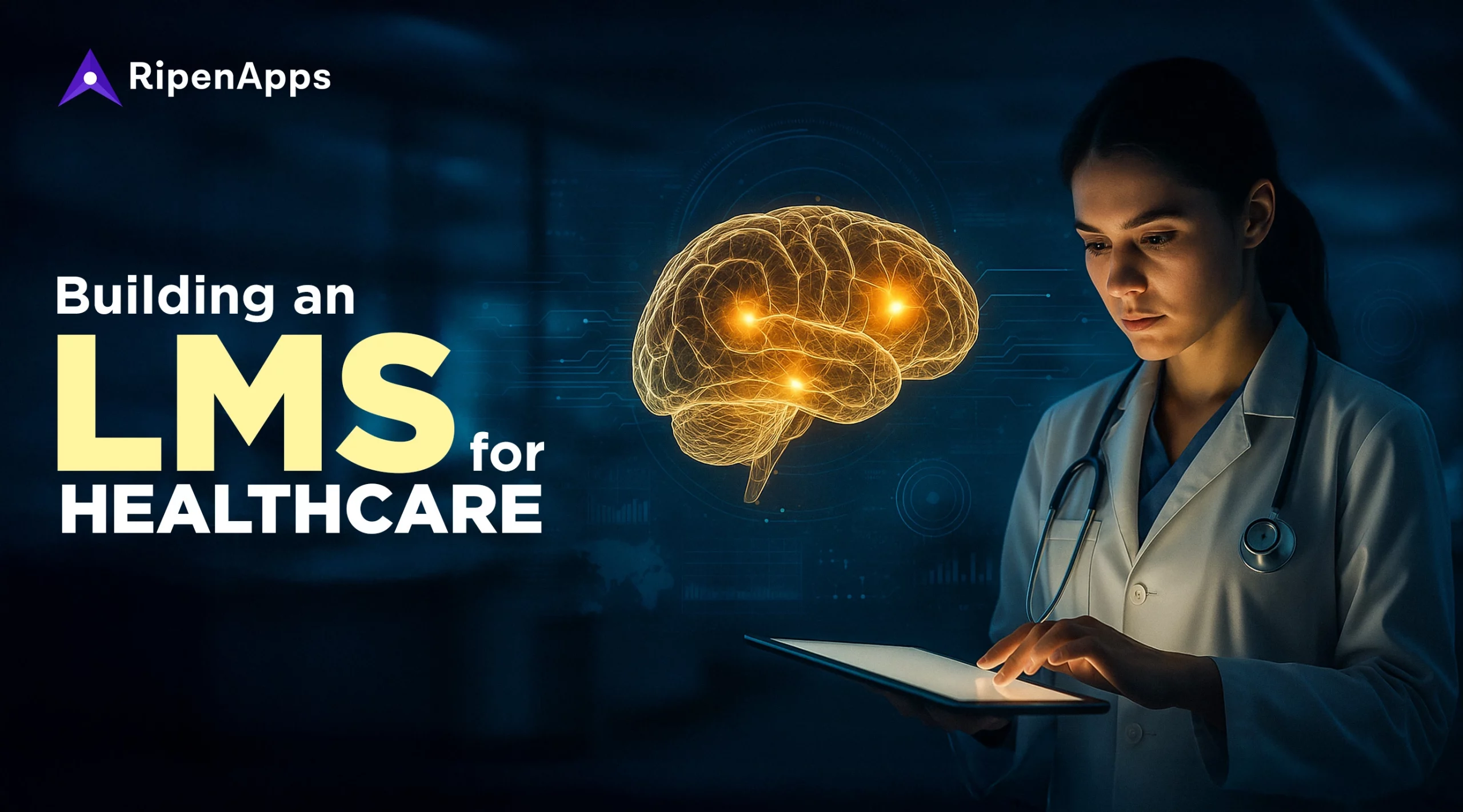






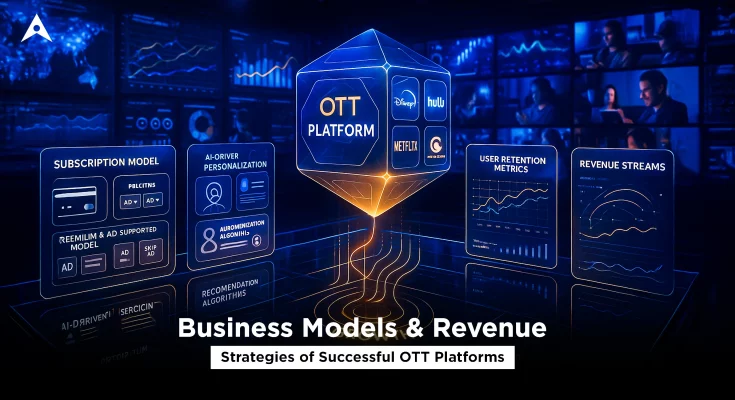
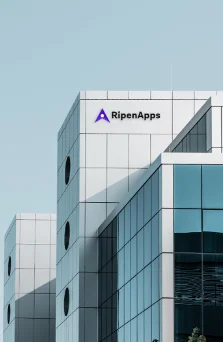
 India
India USA
USA Australia
Australia Canada
Canada UK
UK UAE
UAE
